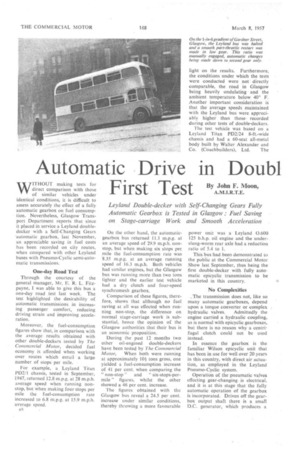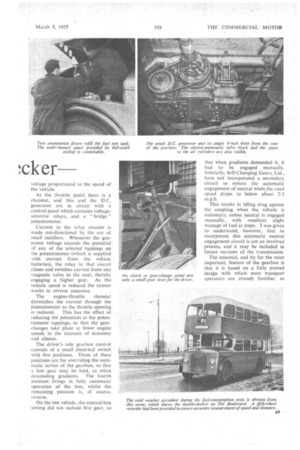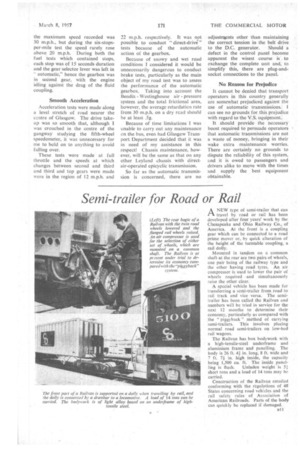Automatic Drive in Doubl
Page 42

Page 43

Page 44

Page 45

If you've noticed an error in this article please click here to report it so we can fix it.
c1( er
First Test By Aj.mohin.RF.T..EM. oon,
Leyland Double-decker with Self-Changing Gears Fully Automatic Gearbox is Tested in Glasgow : Fuel Saving on Stage-carriage Work and Smooth Acceleration
WITHOUT making tests for direct comparison with those of similar vehicles under identical conditions, it is difficult to assess accurately the effect of a fully automatic gearbox on fuel consumption. Nevertheless, Glasgow Transport Department reports that since it placed in service a Leyland doubledecker with a Self-Changing Gears 'automatic gearbox, last November, an appreciable saving in fuel costs has been recorded on city routes, when compared with other Leyland buses with Pneurno-Cyclic semi-automatic transmissions.
One-day Road Test Through the courtesy of the general manager, Mr. E. R. L. Fitzpayne, I was able to give this bus a one-day road .test last week. The test highlighted the desirability of automatic transmissions in increasing passenger comfort, reducing driving strain and improving acceleration.
Moreover, the fuel-consumption figures show that, in comparison with the average results obtained with other double-deckers tested by The Commercial Motor, decided fuel economy is afforded when working over routes which entail a large number of stops per mile.
For example, a Leyland Titan PD2/1 chassis, tested in September, 1947, returned 12.8 m.p.g. at 28 m.p.h. average speed when running nonstop, but when making four stops per mile the fuel-consumption rate increased to 6.8 mpg. at 15.9 m.p.h. average speed.
[ix On the other hand, the automaticgearbox bus returned 11.1 m.p.g. at an average speed of 29.9 m.p.h. nonstop, but when making six stops per mile the fuel-consumption rate was 8.35 m.p.g. at an average running speed of 16.3 m.p.h. Both vehicles had similar engines, but the Glasgow bus was running more than two tons lighter and the earlier test vehicle had a dry clutch and four-speed synchromesh gearbox.
Comparison of these figures, therefore, shows that although no fuel saving at all was effected when running non-stop, the difference on normal stage-carriage work is substantial, hence the opinion of the Glasgow authorities that their bus is an economic proposition.
During the past 12 months two other oil-engined double-deckers have been tested by The Commercial Motor. When both were running at approximately 10+ tons gross, one yielded a fuel-consumption increase of 41 per cent. when comparing the "non-stop" and " six-stops-permile " figures, whilst the other showed a 46 per cent. increase.
The figures obtained with the Glasgow bus reveal a 24.5 per cent. increase under similar conditions, thereby throwing a more favourable light on the results. Furthermore, the conditions under which the tests were conducted were not directly comparable, the road in Glasgow being heavily undulating and the ambient temperature below 40° F. Another important consideration is that the average speeds maintained with the Leyland bus were appreciably higher than those recorded during other tests of double-deckers.
The test vehicle was based on a Leyland Titan PD2/24 8-ft.-wide chassis and had a 60-seat all-metal body built by Walter Alexander and Co. (Coachbuilders), Ltd. The power unit was a Leyland 0.600 125 b.h.p. oil engine and the underslung-worm rear axle had a reduction ratio of 5.4 to 1.
This bus had been demonstrated to the public at the Commercial Motor Show last September, thus being the first double-decker with fully automatic epicyclic transmission to be marketed in this country.
No Complexities
The transmission does not, like so many automatic gearboxes, depend upon a torque converter or complex hydraulic valves. Admittedly the engine carried a hydraulic coupling, as is normal with epicyclic gearboxes, but there is no reason why a centrifugal clutch could not be used instead.
In essence the gearbox is the familiar Wilson epicyclic unit that has been in use for well over 20 years in this country, with direct air actuation, as employed in the Leyland Pneumo-Cyclie system.
Operation of the pneumatic valves effecting gear-changing is electrical, and it is at this stage that the fully automatic operation of the gearbox is incorporated. Driven off the gearbox output shaft there is a small D.C. generator, which produces a voltage proportional to the speed of the vehicle.
At the throttle pedal there is a rheostat, and this and the D.C. generator are in circuit with a control panel which contains voltagesensitive relays, and a "bridge' potentiometer.
Current in the relay circuits is made uni-directional by the use of small rectifiers. Whenever the generator voltage exceeds the potential of any of the selected tappings on i he potentiometer (which is supplied with current from the vehicle batteries), the relay in that circuit closes and switches current from one magnetic valve to the next, thereby engaging a higher gear. As the vehicle speed is reduced the system works in reverse sequence.
The engine-throttle rheostat diminishes the current through the potentiometer as the throttle opening is reduced. This has the effect of reducing the potentials at the potentiometer tappings, so that the gearchanges take place at lower engine speeds in the interests of economy and silence.
The driver's sole gearbox control consists of a small electrical switch with five positions. Three of these positions are for overriding the automatic action of the gearbox, so that -a low gear may be held, as when descending gradients. The fourth position brings in fully automatic operation of the box, whilst the remaining position k, of course, reverse.
On the test vehicle, the control-box setting did not include first gear, so that when gradients demanded it, it had to be engaged manually. Similarly, Self-Changing Gears, Ltd., have not incorporated a secondary circuit to ensure the automatic engagement of neutral when the road speed drops to below about 2-3 m.p.h.
This results in idling drag against the coupling when the vehicle is stationary; unless neutral is engaged manually, with resultant slight wastage of fuel at stops. .T was given to understand, however, that to incorporate this automatic neutral engagement circuit is not an involved process, and it may be included in future versions of the transmission.
The essential, and by far the most important, feature of the gearbox is that it is based on a fully proved design with which most transport operators are already familiar, so that no new and unfamiliar servicing techniques are needed. As long ago as January, 1951, Self-Changing Gears, Ltd., introduced their M.W. automatic control, from which the V.S. system has been evolved.
A test load of 29 cwt. had been placed on the lower deck of the bus. In addition to these weights, there were at least four passengers (plus the driver) throughout the tests.
The bus was tested, therefore, with a load equivalent to 27 passengers, this being the figure considered by the operators to give the best average results for service running. A fifth wheel and two 2-gal. fuel test tanks had been supplied by Glasgow Transport Department for my test.
810
For the first ;test the bus was taken out to Gardner Street, Glasgow, which has a maximum gradient of at least 1 in 6. Starting from a standstill at the bottom of the hill, and using full throttle, the bus was soon brought down into second gear. At full power in this gear it came to rest but was prevented from rolling backwards by the action of the hydraulic coupling.
Low gear was then engaged manually, and on the 1-in-6 section several re-starts were made successfully with only part throttle opening and without undue slipping of the coupling. The hand brake held the vehicle in perfect safety. Had the vehicle not been stopped on this gradient it would have been easy to engage first gear manually while still on the move.
Next the bus was taken out on the Great Western Road-The Boulevard. During the run through town, with a corporation driver at the wheel, I was able to appreciate as a passenger the smooth action of the transmission, the only indication of gear changes being given by the alteration in the engine note.
On the Boulevard one of the fuel test tanks was topped 'up to the neck and the fifth wheel was put into operation. A six-mile out-and-return circuit of this undulating dual carriageway was used for the tests and during the non-stop run a speed of 30-35 m.p.h.\ was maintained.
When making two stops per mile the maximum speed recorded was 30 m.p.h., but during the six-stopsper-mile test the speed rarely rose above 20 m.p.h. During both the fuel tests which contained stops, each stop was of 15 seconds duration and the gear selector lever was left in " automatic," hence the gearbox was in second gear, with the engine idling against the drag of the fluid coupling.
Smooth Acceleration
Acceleration tests were made along a level stretch of road nearer the centre of Glasgow. The drive takeup was so smooth that, although I was crouched in the centre of the gangway studying the fifth-wheel speedometer, it was unnecessary for roe to hold on to anything to avoid falling over.
These tests were made at full throttle and the speeds at which changes between second and third and third and top gears were made were in the region of 12 m.p.h. and 22 m.p.h. respectively. It was not possible to conduct " direct-drive " tests because of the automatic action of the gearbox.
Because of snowy and wet road conditions I considered it would be unnecessarily dangerous to conduct brake tests, particularly as the main object of my road test was to assess the performance of the automatic gearbox, Taking into account the Bendix Westinghouse air pressure system and the total frictional area, however, the average retardation rate from 30 m.p.h. on a dry road should be at least .5g.
Because of time limitations I was unable to carry out any maintenance on the bus, even had Glasgow Trans port Department decided that it was in need of my assistance in this respect! Chassis maintenance, however, will be the same as that on any other Leyland chassis with direct. air-operated epicyclie transmission.
So far as the automatic transmission is concerned, there are no adjustments other than maintaining the correct tension in the belt drive to the D.C. generator. Should a defect in the control panel become apparent the wisest course is to exchange the complete unit and, to simplify this, there are plug-andsocket connections to the panel.
No Reason for Prejudice
It cannot be denied that transport operators in this country generally are somewhat prejudiced against the use of automatic transmissions. I can see no grounds for this prejudice with regard to the V.S. equipment.
It should provide the necessary boost required to persuade operators that automatic transmissions are not a waste of money, bringing in their wake extra maintenance worries. There are certainly no grounds to dispute the reliability of this system, and it is owed to passengers and drivers alike to move with the times and supply the best equipment obtainable.




































































































